Thank you for visiting! By the way… any links on this page that lead to products on Amazon and other stores/partners are affiliate links Aquarium Store Depot earns a commission if you make a purchase.
Have you ever seen a fish that has been around for 400 million years and resembles a mix between an eel and a snake? Meet the Senegal Bichir, also known as the Dinosaur Bichir. With their unique appearance and predatory nature, creating a community tank with these ancient creatures requires careful consideration of their tank mates. Ready to dive into the world of Bichirs and discover the best Bichir tank mates for them? Let’s get started!
Key Takeaways
- Choose tank mates for Bichirs carefully, understanding their behavior and needs
- Small tankmates are bad choices as they can be eaten
- A large tank is a must if you want to keep other tankmates
Understanding Them
The Senegal Bichir is a species of freshwater fish that has been able to survive over millions of years without major changes in their physical characteristics1. They are easily recognized by their elongated, eel-like bodies and scaly skin, sharp dorsal fins, short rounded tails, and visible teeth. These features make them an interesting addition to any aquarium, but it can be challenging to find tank mates due to their predator nature as well as specific needs.
Bichirs should primarily feed on meat or aquatic invertebrates since they are carnivorous and could live for up to 15 years, making it all the more important to research this ambush predator’s behavior prior to introducing other types of fish into the environment. What’s even more unique about these bottom dwellers is how they take advantage of both their gills and lungs to survive!
We need to keep in mind what makes the Senegal bichir so different from others while looking for suitable tank mates based on our knowledge regarding behaviors such as capabilities before joining two separate worlds within one ecosystem.
Overview Of Types
There are various types of Bichirs, all with different sizes. Below are a few with their average sizes below for reference.
- Dinosaur Bichir – 12 inches
- Ornate Bichir – 24 inches
- Saddled – 30 inches
- Delhezi – 14 inches
For this post, we’ll focus on the Dinosaur Bichir. Other Bichirs will require larger tanks and more careful tankmate selection.
Ambush Predator Nature
Bichirs are ambush predators, so it is necessary to choose tank mates that they cannot view as prey or competition for hiding places. Fish that inhabit the middle and top part of an aquarium and active during the daytime work well. Just ensure there’s sufficient space to establish their individual territories. Silver dollar fish make excellent peaceful partners since conflicts can be prevented this way. If looking at larger types, note aggression levels beforehand too!
With regards to food items like frozen food, one should pick carefully and try to feed separately to avoid aggression. Keep in mind that due to their ambush nature, they will sneak up on fish and eat them. This leaves out the typical fast schooling fish like Danios that can actually be snuck up on and eaten.
Ideal Aquarium Size And Water Parameters
When constructing a habitat for Bichirs, the minimum tank size should be around 55 gallons. It is crucial to ensure that conditions such as water temperature (74-82°F) and pH level (6.2-7.8) are kept stable in order to provide them with an optimal living environment. They prefer a of sandy substrate that replicates their natural freshwater habitats, plus plenty of hiding spots where fish can make themselves at home safely and conduct their ambush behaviors.
The next step would include introducing compatible tank mates who possess particular traits that could easily fit into this established ecosystem alongside our beloved Bichir friends (and not become lunch).
Also, note that Bichirs are compatible with aquatic plants. However, not all fish on this list will be.
Top 10 Bichir Tank Mates
Bichirs should be kept with certain fish species when setting up a community tank to ensure harmony and visual appeal. This diet includes fish that are going to be generally safe to keep with them but be aware that every fish is different and could have a more aggressive or passive personality than what is considered normal for their species. With that, let’s get started.
1. Eels

- Scientific Name: Various
- Adult Size: 6 to 150+ inches
- Water Temperature: 72°F to 82°F
- Minimum tank size: 20 – 55+ gallons
- Care Level: Moderate
- Diet – Carnivore
- Origin – Various
- Swimming Level – Bottom
Eels make potentially great tank mates. These creatures all prefer to dwell at the bottom of the tank, where they can hide away from potential conflicts with other occupants. This makes them a great fit as peaceful companions in your aquarium environment (with the right fish). With ample hiding spots supplied alongside compatible diets for each species, you’ll be sure that both parties live harmoniously together. Lots of shelter and hiding spots are a must to house both species.
2. Silver Dollars

- Scientific Name: Metynnis argenteus / Metynnis hypsauchen
- Adult Size: 6 inches
- Water Temperature: 72°F to 82°F
- Minimum tank size: 75 gallons
- Care Level: Easy
- Diet – Omnivore
- Origin – South America
- Swimming Level – Middle to top
Silver Dollars are an ideal addition to a community tank as they are peaceful tank mates and social. These freshwater fish thrive in schools of at least six but will require ample swimming space for them all. They have slim build bodies that make for interesting viewing in the aquarium while having a diet mostly based on plants – they’re omnivores so that other foods may be offered too!
These Silver Dollars can make great companions with Bichirs and other fish. When given proper care and attention, they both create quite an engaging atmosphere within any tank setup. They are very fast and large, which keeps them from getting targeted by your Bichir.
3. Hoplo Catfish

- Scientific Name: Megalechis thoracata
- Adult Size: 6 inches
- Water Temperature: 72°F to 82°F
- Minimum tank size: 40 gallons
- Care Level: Moderate
- Diet – Omnivore
- Origin – South America
- Swimming Level – Middle to top
Hoplo Catfish are the perfect tank mates for Bichirs due to their peaceful nature, size, and adaptability. Native to South America, these armored bottom dwellers can grow up to 8 inches in length, making them an ideal companion for a Bichir. For optimal living conditions, it is necessary that when housing Hoplo catfish alongside Bichirs you have a minimum of 55 gallons as well as numerous hiding spots with sandy substrate present within the aquarium environment so both species may thrive comfortably together.
Note that this catfish is considered on the riskier end. Not because the fish could get eaten but because Bichirs do have a habit of biting off the whiskers of catfish. Careful observation should be taken and action should be taken immediately if a fish is attacked.
4. Oscars
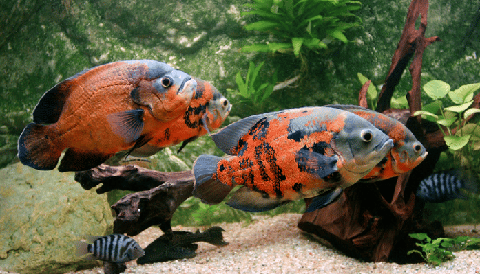
- Scientific Name: Astronotus ocellatus
- Adult Size: 12+ inches
- Water Temperature: 74°F to 81°F
- Minimum tank size: 55 gallons
- Care Level: Moderate
- Diet – Omnivore
- Origin – South America
- Swimming Level – Middle to top
Oscars are large and hardy aquatic creatures that, with the proper precautions taken to prevent aggression between them and Bichirs, can peacefully inhabit the same tank. These fish showcase a dark body complete with bright orange designs on their head as well as fins for extra visual interest in any aquarium setting. Pellets and frozen food will comprise most of an Oscar’s diet, but they also benefit from some live foods such as worms, insects, and occasionally feeder fish (if that’s your thing)!
5. Tinfoil Barb

- Scientific Name: Barbonymus schwanenfeldii
- Adult Size: 14 inches
- Water Temperature: 72°F to 77°F
- Minimum tank size: 75 gallons
- Care Level: Moderate
- Diet – Omnivore
- Origin – East Asia
- Swimming Level – All
Tinfoil barbs are a highly engaging species native to Southeast Asia that thrive in community tanks. These fish require ample space and an array of dietary components, including both plant-based foods and protein-rich options for best health results. They can grow quite large too!
When housing these active schooling fish with Bichirs, be sure your tank is at least a 6 foot long tank so their needs can be met. With adequate care, Tinfoil Barbs coexist peacefully alongside their tankmates, leading to hours of viewing pleasure from the vibrant aquarium environment created by these two beautiful creatures.
6. Knife Fish
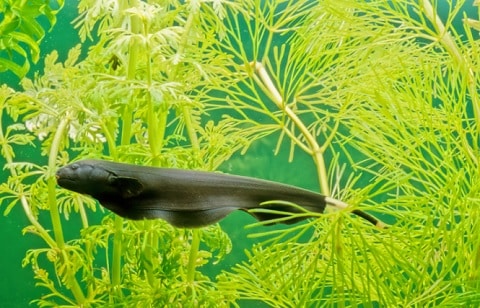
- Scientific Name: Apteronotus albifrons
- Adult Size: 14+ inches
- Water Temperature: 73°F to 82°F
- Minimum tank size: 100 gallons
- Care Level: Carnivorous
- Diet – Omnivore
- Origin – South America
- Swimming Level – Middle to Bottom
When housing Knife Fish with Bichirs, creating an environment suitable for both is essential. This means providing a large tank of at least 125 gallons and plenty of cover to comfortably house both. These peaceful fish need the ability to hide away from light during the day. They must be fed meaty treats, including worms, larvae, shrimp, and other small fish(via silver sides if you go the frozen route) in order to stay healthy, and if adequately cared for, they can make great companions!
Their unique rod-shaped tail without dorsal or caudal fins helps distinguish them as one-of-a-kind amongst aquarium occupants, making excellent tank mates with your Bichir.
7. Bala Shark

- Scientific Name: Balantiocheilos melanopterus
- Adult Size: 12 inches
- Water Temperature: 75°F to 82°F
- Minimum tank size: 125 gallons
- Care Level: Moderate
- Diet – Omnivore
- Origin – Southeast Asia
- Swimming Level – Middle to Top
Bala Sharks are a Southeast Asian species of active, social fish that can grow up to 12 inches long, making them ideal companions for Bichirs. For the best results when keeping Balas with these bottom dwellers, an aquarium size of 125 gallons is necessary, and water conditions must be kept between 72-82°F. They like to socialize and should be kept in groups – hence the larger aquarium size requirement.
With proper care, you can create a thriving, dynamic tank environment where both species happily exist.
8. Giant Gourami

- Scientific Name: Osphronemus goramy
- Adult Size: 18 inches
- Water Temperature: 69°F to 86°F
- Minimum tank size: 200 gallons
- Care Level: Moderate
- Origin: Southeast Asia
- Swimming Level – Middle to Top
Giant Gouramis are relatively placid, sizable fish, which can be kept with Bichirs in a suitably spacious tank that includes areas for them to hide. These specimens have the potential to reach up to 18 inches and live an average of 10 years so they provide a good companion option when placed alongside Bichirs.
Tank size is the biggest hurdle to house both a Bichir and a Giant Gourami. The Gouramis themselves need a 200+ gallon aquarium, keeping them out of the reach of many aquarists. However, it’s a great combination if you are able to house them in a tank that large.
9. Arowana
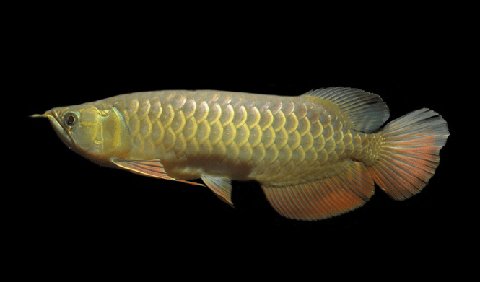
- Scientific Name: Scleropages formosus
- Adult Size: 2+ feet
- Water Temperature: 75°F to 82°F
- Minimum tank size: 250 gallons, 8 foot long tank
- Care Level: Advanced
- Origin: Amazon
- Swimming Level – Middle to Top
Arowanas, native to tropical climates and growing large in size, are a good companion fish for Bichirs when kept in tanks of 250 gallons or larger. These predatory creatures need a high-protein diet comprised mostly of live foods such as worms, insects, and shrimp as well as frozen meals like fish. When given proper care, including ample space and the right food, Arowanas can create an exciting atmosphere with their tank mates while being healthy simultaneously. As long as you keep a tank large enough, it is possible to keep both species.
10. Denison Barbs

- Scientific Name: Sahyadria denisonii
- Adult Size: 4 inches
- Water Temperature: 72°F to 79°F
- Minimum tank size: 40 gallons
- Care Level: Moderate
- Origin: Southern India
- Swimming Level – Middle to Top
Denison barbs are active and social fish native to Southeast Asia. When given enough room for swimming in a community tank with plenty of variety in their diet, these schooling creatures can happily co-exist with Bichirs. With proper care provided by an aquarist, Denison Barbs will create dynamic aquarium life that engages the viewer.
These two fish species in a community tank provide a colorful display when harmoniously kept together. However, careful observation should be made as it is possible for the Bichir to eat them.
11. Elephant Nose Fish

- Scientific Name: Gnathonemus petersii
- Adult Size: 9 inches
- Water Temperature: 73°F to 82°F
- Minimum tank size: 55 gallons
- Care Level: Difficult
- Origin: Africa
- Swimming Level – Bottom of the tank
Elephant Nose Fish are a distinctively sized species of fish that can co-exist well with Bichirs, but in order for this to be the case, they need specific tank conditions. These medium size fish have several characteristics that you should take into consideration when setting up their home. They can act both sensitive and aggressive, and an aquarium not smaller than 50 gallons is required due to their dimensions. Using sand or silt as substrates is essential since these will help protect its delicate trunk from any harm.
Being carnivorous creatures, they must feed on bugs and larvae while also having access to various types of worms & crustaceans. When housing Elephant Noses along side Bichir, provide them generous space plus places where they could hide out – this way preventing possible aggression among them. With good care given by aquarists, Elephant Nose Fish would look splendid swimming alongside your precious finned friends!
12. African Butterfly Fish

- Scientific Name: Pantodon buchholzi
- Adult Size: 6 inches
- Water Temperature: 75°F to 82°F
- Minimum tank size: 30 gallons
- Care Level: Moderate
- Origin: Africa
- Swimming Level – Top
African Butterfly Fish are somewhat aggressive inhabitants of the top-most area in an aquarium and can cohabit with Bichirs when proper conditions are met. Coming from Africa, these fish need to have a tank that is at least 30 gallons large, which provides them plenty of hiding places and live or frozen foods available so they can feed their carnivorous diet. They should work well with Bichirs since they take up difficult aquarium areas.
13. Clown Loaches
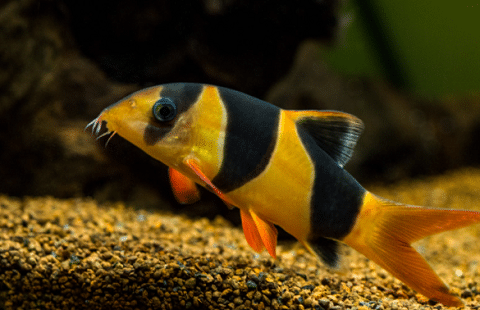
- Scientific Name: Botia macracantha
- Adult Size: 12 inches
- Water Temperature: 75°F to 85°F
- Minimum tank size: 100 gallons
- Care Level: Difficult
- Origin: Indonesia
- Swimming Level – Bottom
Clown Loaches, native to Southeast Asia and renowned for their playful social nature, make a fun addition to any community tank. To ensure the health of these fish when housed with Bichirs, it is necessary that they be placed in a group. This will push up your tank requirements to the larger tanks available in the hobby.
As long as you take into account such considerations, your entertaining pet clowns will enjoy living alongside other species like Bichirs!
14. Severum

- Scientific Name: Heros severus
- Adult Size: 8 inches
- Water Temperature: 75°F to 84°F
- Minimum tank size: 55 gallons
- Care Level: Moderate
- Origin: South America
- Swimming Level – Bottom to Mid
Severums, native to South America and growing up to 8 inches in length, are a species of cichlid that can be housed with Bichirs. It is arguably considered the perfect tankmate for a Bichir.
This gentle giant requires at least 75 gallons of aquarium size when housed with a bichir, as well as offering numerous hiding places such as caves or driftwood. They need a balanced diet, including high quality pellets along with frozen foods for optimal growth and health. This is a slam dunk pick that shouldn’t have issues with each other as long as you have a large enough aquarium.
15. Leopard Bush Fish

- Scientific Name: Ctenopoma acutirostre
- Adult Size: 6 inches
- Water Temperature: 72°F to 82°F
- Minimum tank size: 50 gallons
- Care Level: Moderate
- Origin: Africa
- Swimming Level – Bottom to Mid
Leopard Bush Fish, native to Africa with an attractive yellowy-brown color and dark spots all over their tall bodies, is a visually striking addition compatible in community tanks. These ambush predators need at least 50 gallons of water and should have plenty of hiding places such as hides or caves for them to feel safe. They must get fed live or frozen items like bloodworms, brine shrimp, and other meat based meals on a regular basis for proper care.
They could get eaten by larger Bichirs, but Dinosaur Bichirs should be fine.
Honorable Mentions
We left some fish off our list since we limited ourselves to 15. Here are some others you can consider.
- Convict Cichlid
- Pink Convict Cichlid
- Blue Acara
- Peacock Bass
Bad Choices
When selecting suitable tank mates for Bichirs, it’s important to be mindful of size, aggression levels, and other particular needs. Opting for tankmates such as fish species that are less aggressive, at least a medium size, and aren’t slow will increase your chances of success. In saying this, here are a few fish species to avoid:
- Small schooling nano fish
- Danios – while fast, they will get ambushed
- Small cichlids
- Corydoras catfish – too small
- Bettas
- Plecos – they will suck on the slime coat of the Bichir
- Any fish on this list purchased small – while they could be compatible as adults juvenile fish like Bala Sharks could be snacks for a Bichir when small!
Frequently Asked Questions
What fish can be with a bichir?
A fish needs to at least medium sized and non aggressive larger fish to live with a Bichir. This would include possible mates like Oscars, Silver Dollars, Severums, or top dwelling fish like African Butterfly fish
Can bichir live in a community tank?
Bichir can coexist in a community tank as long as there is plenty of room and hiding places. As they are relatively slow-moving, it’s best to avoid putting them with aggressive fish who could harass or scare the bichirs. Their diet should include live foods such as bloodworms and frozen items like brine shrimp to meet their nutritional needs.
How big of a tank do Bichirs require?
Be sure to have a minimum of 90 gallons when planning for Adult Bichirs. This size tank is essential in order to provide them with enough space and keep any possible aggression low among tankmates.
What type of substrate is best for Bichir?
A sandy substrate is highly recommended for Bichirs, allowing them to hide and burrow in their surroundings. A sandy substrate allows them to exhibit their natural behaviors and conduct their ambush predator actions – though you should pick fish they cannot fit in their mouths!
Are Bichirs compatible with smaller fish species?
Given their predatory nature, it is suggested that smaller fish species not be kept with Bichirs as they may choose to attack them. They are also ambush predators and can eat small athletic fish like neon tetras and zebra danios.
Closing Thoughts
When selecting tank mates for Bichirs, it is important to consider the size, aggression levels, and needs of each fish species. I hope this list is of use to you in finding the right tankmates for your setup. Ultimately, every Bichir is different. They can be model citizens or absolute terrors. Always have a backup plan when it comes to any fish that can be aggressive or eat fish.
Have you kept Bichirs with fish before? Let us know in the comments below what your experience has been with keep a Dinosaur Bichir Tank. Thank you for reading and see you next time!
- About the Author
- Latest Posts
I’m thrilled that you found Aquarium Store Depot! Here you’ll find information on fish, aquariums, and all things aquatics related. I’m a hobbyist (being doing this since I was 11) and here to help other hobbyists thrive with their aquariums! I adhere to a high quality Editorial Process and Review products with real life field usage and practical analysis.

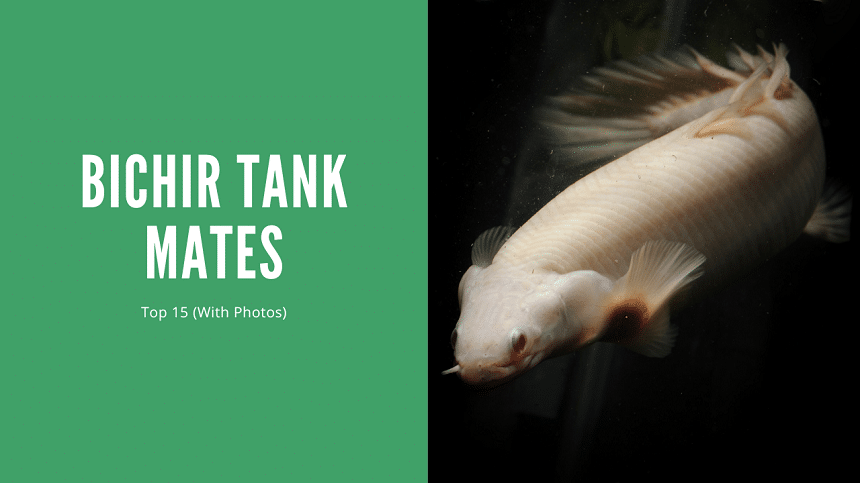




i have mine with a male and female betta, dwarf frog, 2 mollies, 1 catfish and 3 snails